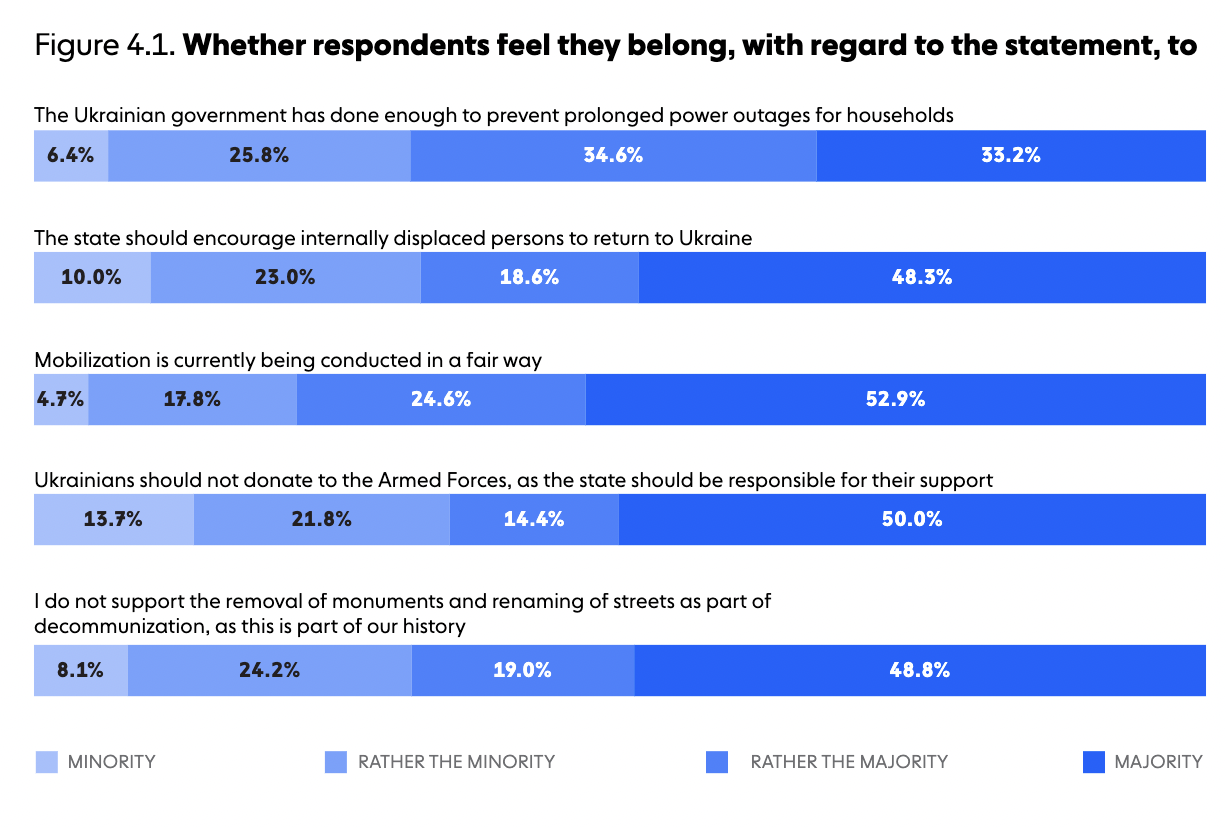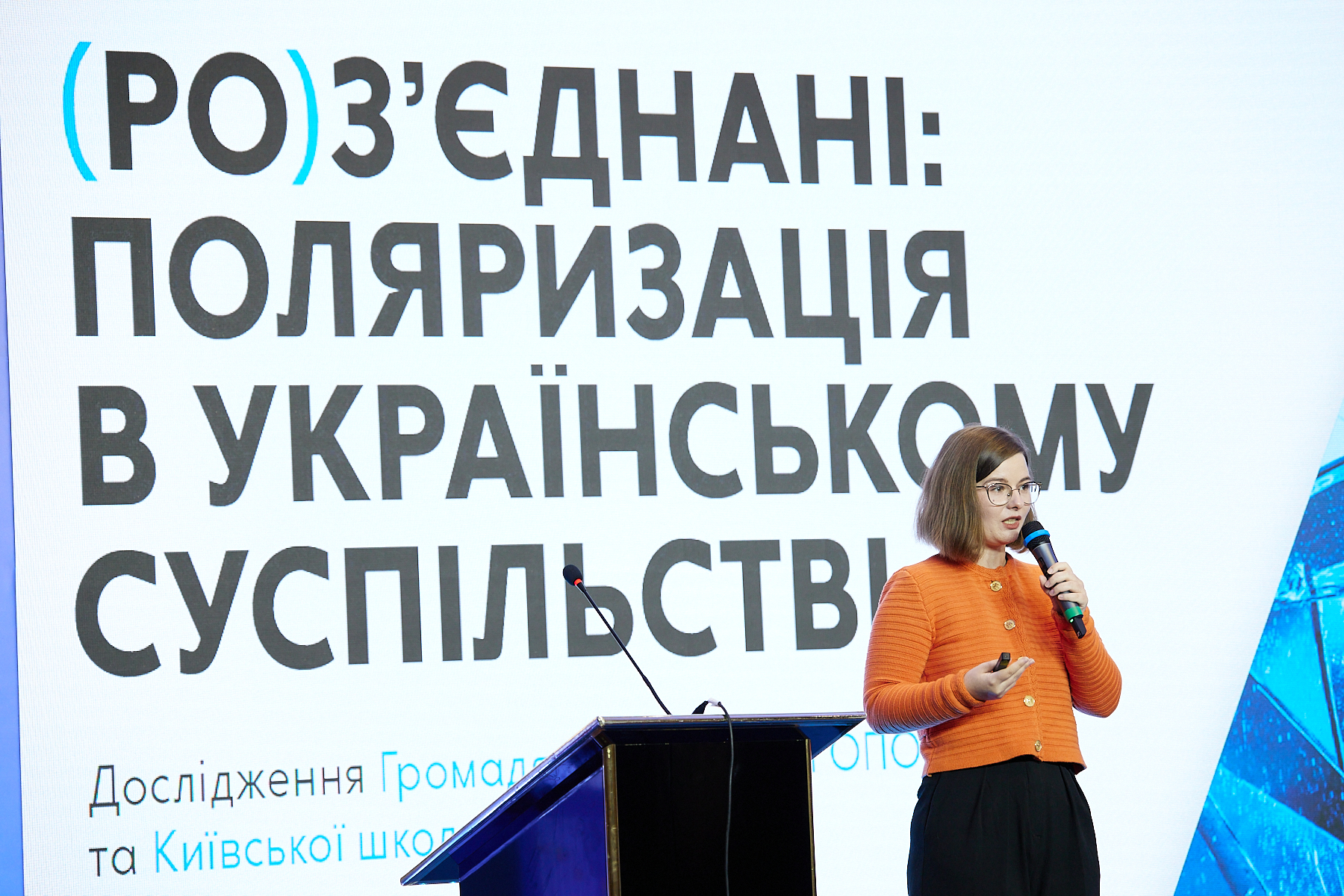After delivering a presentation of OPORA’s study “(Dis)connected: polarization in Ukrainian society”, our team realized that the last section of our study requires further clarification. We are grateful to each and every one of you for pointing out that the results presented in this section are not fully clear. We really appreciate your feedback. In this article, we will try to break it down for you.
Let us remind you which section we are talking about. One of the elements of our research was to find out how strongly do respondents believe that their opinions and views are shared by the majority of Ukrainians. For this purpose, we presented our respondents with a list of five socio-political statements and asked them two questions one after the other:
- “How many percent of adult Ukrainians living in Ukraine do you think share these opinions?” – respondents estimated the percentage of Ukrainians who, in their opinion, agree with each statement by picking a number between 0 and 100.
- “To what extent do you agree with these opinions?” – respondents rated their own agreement or disagreement with each statement on a scale of 1 to 5 (where 1 means completely disagree, and 5 means completely agree)
The 5 statements were as follows:
- “The Ukrainian government has done enough to prevent prolonged power outages for households.”
- “The state should encourage internally displaced persons to return to Ukraine.”
- “Mobilization is currently being conducted fairly.”
- “Ukrainians should not donate to the Armed Forces, as the state should be responsible for their support.”
- “I do not support the removal of monuments and renaming of streets as part of decommunization, as this is part of our history.”
After that, we compared two indicators: respondents’ estimates of the percentage of Ukrainians who agree or disagree with the above-mentioned statements and respondents’ answers to the question whether they agree with these statements or not. In this way, we determined whether the respondents believe that the majority of Ukrainians think the same way as they do. We got the following results:

How did we calculate? We used a very simple method of analysis: if the respondent’s subjective assessment of the opinion of the majority of Ukrainians coincided with his/her own opinion on any given statement, we classify the respondent as identifying himself/herself with majority. If the respondent’s assessment of the majority opinion is different from his/her own opinion on any given statement, we classify the respondent as identifying himself/herself with minority. We have divided our scale into four parts for higher precision of results:
|
Respondent identifies himself/herself with: |
Explanation |
Respondent’s answers |
|
Minority |
Respondents who believe that only 0-25% of Ukrainians think the same way as they do |
|
|
Rather minority |
Respondents who believe that 26-50% of Ukrainians think the same way as they do |
|
|
Rather majority |
Respondents who believe that 51-75% of Ukrainians think the same way as they do |
|
|
Majority |
Respondents who believe that 76-100% of Ukrainians think the same way as they do |
|
For example, if a respondent “totally disagrees” with a statement but believes that 90% of Ukrainians agree with it, he/she is considered as identifying himself/herself with minority, and vice versa: if a respondent “totally agrees” with a statement and believes that 90% of Ukrainians also agree with it, he/she is considered as identifying himself/herself with majority. Therefore, the “majority” and “minority” groups include both those who agree with the statement and those who disagree with it.
Why did we do this? We were interested in finding out whether there are grounds to believe that the so-called “silent majority” has emerged in Ukraine, in other words, how many respondents believe that other Ukrainians do not share their views (meaning that they are less socially acceptable and not worth telling about). Firstly, those who identify themselves with minority may be more inclined to refrain from expressing their views in public and giving honest answers to sociologists and other researchers. Secondly, such people are more vulnerable to political manipulation and hate speech: for example, they can be more easily convinced that those who share opposing views are not only different, but also potentially dangerous to them. This is the modus operandi of populist politicians who instill the idea of “us against the rest” into mass consciousness. About a third of respondents believe that they are in minority because of their views. Therefore, this issue warrants further investigation. OPORA’s team or our colleagues will carry out a study to explain the reasons for “otherisation” and such an attitude towards those who share opposing views.
Why did we not publish the graphs that show to what extent respondents agree or disagree with the statements? We felt it would be unfair of us to publish this information and draw any conclusions about selected socio-political issues. We did not set ourselves the goal of getting an understanding of what Ukrainians think about mobilization or decommunization. They served as test questions that helped us understand whether respondents identify themselves with minority. These are important topics, but they go beyond the scope of this study (otherwise, respondents would have to answer almost a hundred questions, and none of us would want to be in their place). To get a better understanding of Ukrainian people’s attitudes and opinions on each of the selected topics, it would be worth adding a few clarifying questions to each of the questions that would address different aspects of every problem. Simply put, the answer to the question of whether or not respondents agree with the statement “mobilization is being conducted in a fair way” does not explain why they think so. Without this knowledge it is impossible to elaborate any productive policy recommendations.
We hope that we cleared up all misunderstandings about this section of research study.
We apologize to the guests of the event and readers of the report who may have been confused by our presentation. Your feedback helps us improve – please send your suggestions and inquiries to [email protected]
